
Are your students having difficulty understanding math terminology? Try this A-Z glossary on math related terms. It's quick, easy to read, and very complete.
- Subject:
- Mathematics
- Material Type:
- Reading
- Date Added:
- 12/01/2023

Are your students having difficulty understanding math terminology? Try this A-Z glossary on math related terms. It's quick, easy to read, and very complete.

This is an introduction to finding the arc length and area of sectors of circles. Students should have the formulas for Circumference and Area of circles.

Use Pi (3.14) to find the area and circumference of a circle.

What is pi, anyway? Students explore the relationship between circumference and diameter by measuring a variety of circles and use it to derive the formula for circumference.
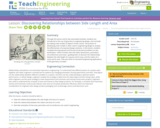
Through this lesson and its two associated activities, students are introduced to the use of geometry in engineering design, and conclude by making scale models of objects of their choice. The practice of developing scale models is often used in engineering design to analyze the effectiveness of proposed design solutions. In this lesson, students complete fencing (square) and fire pit (circle) word problems on two worksheets—which involves side and radius dimensions, perimeters, circumferences and areas—guiding them to discover the relationships between the side length of a square and its area, and the radius of a circle and its area. They also think of real-world engineering applications of the geometry concepts.

This activity provides an opportunity for students to explore the ratio of the circumference of its circle to the length of its diameter in order to generalize the ratio of pi. [3:14]

Students, teachers, and parents alike will enjoy this challenging math site. It contains a clever brain teaser section plus creative problems related to algebra, geometry, measurement, numbers, statistics, and probability. A Spanish version is available.

In this science activity you will examine circular objects and see what you can discover about their sizes. As you explore, you might be surprised at how useful the results can be -- maybe it will inspire you to save up for a bike with bigger wheels!
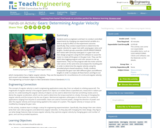
Students work as engineers and learn to conduct controlled experiments by changing one experimental variable at a time to study its effect on the experiment outcome. Specifically, they conduct experiments to determine the angular velocity for a gear train with varying gear ratios and lengths. Student groups assemble LEGO MINDSTORMS(TM) NXT robots with variously sized gears in a gear train and then design programs using the NXT software to cause the motor to rotate all the gears in the gear train. They use the LEGO data logging program and light sensors to set up experiments. They run the program with the motor and the light sensor at the same time and analyze the resulting plot in order to determine the angular velocity using the provided physics-based equations. Finally, students manipulate the gear train with different gears and different lengths in order to analyze all these factors and figure out which manipulation has a higher angular velocity. They use the equations for circumference of a circle and angular velocity; and convert units between radians and degrees.
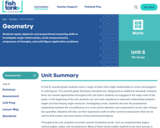
Students apply algebraic and proportional reasoning skills to investigate angle relationships, circle measurements, uniqueness of triangles, and solid figure application problems.
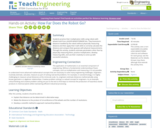
Students practice their multiplication skills using robots with wheels built from LEGO® MINDSTORMS® NXT kits. They brainstorm distance travelled by the robots without physically measuring distance and then apply their math skills to correctly calculate the distance and compare their guesses with physical measurements. Through this activity, students estimate parameters other than by physically measuring them, practice multiplication, develop measuring skills, and use their creativity to come up with successful solutions.

Brush up on your math skills relating to perimeter then try some practice problems to test your understanding.
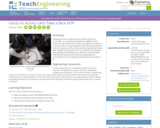
Working as a team, students discover that the value of pi (3.1415926...) is a constant and applies to all different sized circles. The team builds a basic robot and programs it to travel in a circular motion. A marker attached to the robot chassis draws a circle on the ground as the robot travels the programmed circular path. Students measure the circle's circumference and diameter and calculate pi by dividing the circumference by the diameter. They discover the pi and circumference relationship; the circumference of a circle divided by the diameter is the value of pi.
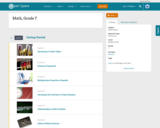

Zooming In On Figures
Unit Overview
Type of Unit: Concept; Project
Length of Unit: 18 days and 5 days for project
Prior Knowledge
Students should be able to:
Find the area of triangles and special quadrilaterals.
Use nets composed of triangles and rectangles in order to find the surface area of solids.
Find the volume of right rectangular prisms.
Solve proportions.
Lesson Flow
After an initial exploratory lesson that gets students thinking in general about geometry and its application in real-world contexts, the unit is divided into two concept development sections: the first focuses on two-dimensional (2-D) figures and measures, and the second looks at three-dimensional (3-D) figures and measures.
The first set of conceptual lessons looks at 2-D figures and area and length calculations. Students explore finding the area of polygons by deconstructing them into known figures. This exploration will lead to looking at regular polygons and deriving a general formula. The general formula for polygons leads to the formula for the area of a circle. Students will also investigate the ratio of circumference to diameter ( pi ). All of this will be applied toward looking at scale and the way that length and area are affected. All the lessons noted above will feature examples of real-world contexts.
The second set of conceptual development lessons focuses on 3-D figures and surface area and volume calculations. Students will revisit nets to arrive at a general formula for finding the surface area of any right prism. Students will extend their knowledge of area of polygons to surface area calculations as well as a general formula for the volume of any right prism. Students will explore the 3-D surface that results from a plane slicing through a rectangular prism or pyramid. Students will also explore 3-D figures composed of cubes, finding the surface area and volume by looking at 3-D views.
The unit ends with a unit examination and project presentations.

Students will measure the circumference and diameter of round things in the classroom and discover the ratio pi. They will see that the ratio of a circle's circumference to its diameter can be used to solve for the circumference when the diameter is known.Key ConceptsStudents have seen circles before, but have not analyzed the relationships between parts of a circle. The ratio of the circumference to the diameter is pi, about 3.14 or about 227. Students see that all of the objects they measure have this ratio (or close, depending on accuracy) and that the ratio is true for all circles. Students also see that the ratio can be used to solve for the circumference of a circle if the diameter (or radius) is known.GoalsMeasure round things looking for similarities.Find the ratio of the circumference to the diameter of those round things.Find a formula to find the circumference of a circle.SWD: Make sure students understand these domain-specific terms:It may be helpful to preteach these terms to students with special needs. If possible, reinforce the definitions of these terms with visual supports (diagrams).ELL: As new vocabulary is introduced, be sure to repeat it several times and to allow students to repeat after you as needed. Write the new words as they are introduced and allow enough time for ELLs to check their dictionaries or briefly consult with another student who shares the same primary language if they wish.ratiocircumferencecirclediameterscatter plot
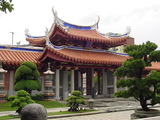
Students critique their work from the Self Check and redo the task after receiving feedback. Students then take a quiz to review the goals of the unit.Key ConceptsStudents understand how to find the area of figures such as rectangles and triangles. They have applied that knowledge to finding the area of composite figures and regular polygons. The area of regular polygons was extended to understand the area of a circle. Students also applied ratio and proportion to interpret scale drawings and redraw them at a different scale.GoalsCritique and revise student work.Apply skills learned in the unit.Understand two-dimensional measurements:Area of composite figures, including regular polygons.Area and circumference of circles.Interpret scale drawings and redraw them at a different scale.SWD: Make sure all students have the prerequisite skills for the activities in this lesson.Students should understand these domain-specific terms:composite figuresregular polygonsareacircumferencescale drawingstwo dimensionalIt may be helpful to preteach these terms to students with disabilities.ELL: As academic vocabulary is reviewed, be sure to repeat it and allow students to repeat after you as needed. Consider writing the words as they are being reviewed. Allow enough time for ELLs to check their dictionaries if they wish.

This multimedia site offers a beginner's guide to understanding the relationship between the diameter and circumference of a circle. This Learn Alberta site offers a video [1:44], interactive exercises and printable extended exercises.
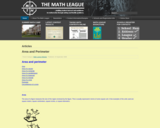
This tutorial provides a brief introduction about what area is, then gives the formulas for area of a square, rectangle, parallelogram, trapezoid, triangle, and circle. Examples of each formula are provided.
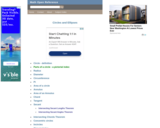
A complete reference guide to circles including parts, angles, and arcs. It provides definitions and interactive activities that enhance further explanation.